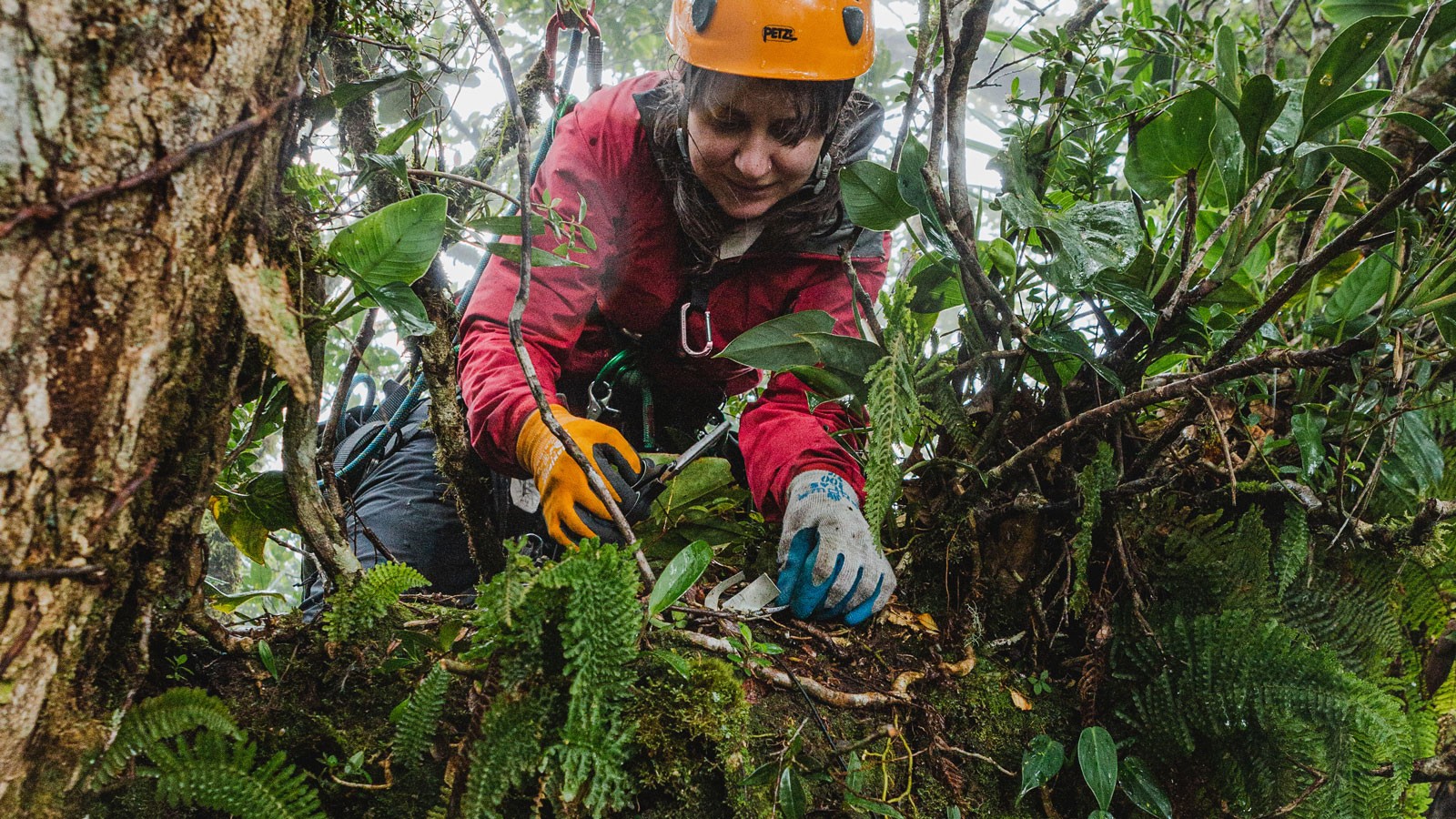In the Treetops: USU Ecology Doctoral Student Studies Canopy Soil Abundance, Chemistry
Jessica Murray publishes in the journal 'Geoderma'; presents at Ecological Society of America Annual Meeting.
By Mary-Ann Muffoletto |
Some 80 feet above ground, USU ecologist Jessica Murray studies soil canopies in tropical montane forests of Costa Rica. The doctoral candidate published findings in the journal 'Geoderma' and presents at the 2023 ESA meeting. (Photo credit: Mario Molina)
When we think of soil, most of us think of dirt on the ground. But a surprising amount of the planet’s soil thrives in the treetops of old-growth forests, high above terra firma.
This organic matter, composed of decaying leaves and branches, airborne particulates and moisture, is called canopy soil or arboreal soil. Its study is relatively new, says Utah State University ecologist Jessica Murray. She’s among researchers unraveling mysteries of the dense, mossy humus that provides rich habitat for insects, birds, fungi, worms and plants, as well as a generous reservoir for carbon storage.
Murray and colleagues from Texas A&M University, the University of Toronto Scarborough and Imperial College London published new information about the enigmatic resource in the July 27, 2023, online edition of Geoderma. The team’s research was supported by USU, the U.S. Department of Agriculture National Institute of Food and Agriculture, and the Natural Sciences and Engineering Research Council of Canada.
“In this study, we sought to understand where canopy soils are found, where they are most abundant, and if their properties — and thus, soil development processes — differ as a function of climate or other small-scale factors,” says Murray, a doctoral student in USU’s Department of Biology and Ecology Center. “This is the first study to look at the distribution patterns of canopy soils across forests and one of very few studies that have sought to examine canopy soil properties.”
Murray collected much of the data for the study some 80 feet above the ground at six primary forest sites across Costa Rica’s Cordillera de Tilarán and Cordillera Volcánica Central, encompassing both Caribbean and Pacific slope mountain ranges. Her field equipment includes climbing gear, ropes, a safety harness and helmet.
“I climbed about 30 trees to collect data,” she says. “And getting to one of those sites was the hardest hike of my life.”
Murray is referring to a site designated “Puesto 1070,” located along a contiguous tract of primary forest, which required a steep trek from about 1,970 feet in elevation to 3,608 — in thick mud.
“It took eight hours to complete the hike just to the study site,” she says. “We were carrying all of our climbing gear, food for eight days, sleeping bags and sampling equipment. Thank heavens we finished that site early, because with our hard-earned appetites, we also nearly finished our food supply ahead of schedule.”
Murray says tree canopies in the tropical montane forest systems are especially dense, with thick moss, soil and an abundance of epiphytes — plants that grow on other plants, often referred to as “air plants” — that are not parasitic and have little or no attachment to other obvious nutrient sources.
“It’s like another world in the air: canopies teeming with plant, insect and animal life,” she says. “I initially conducted surveys to assess canopy soil abundance from the ground with binoculars. But it was really necessary to climb up into the trees to get an accurate picture of what was going on.”
Murray asserts forest canopies store much more carbon that generally assumed.
“It’s kind of a back-of-the-envelope calculation on my part, but one I’m ready to defend and eager to investigate further,” she says. “I think canopy soil stores 0.4 to 4 percent of total soil carbon in the forests where it is found, which is not being counted in ecosystem carbon budgets.”
Mentored by USU Biology Professor John Stark and former USU faculty member Bonnie Waring, the latter now with Imperial College London and an author on the paper, Murray says the team’s results indicate both climate and tree size play an important role in canopy soil abundance, carbon stocks and chemistry.
“Climate, particularly fog and temperature changes, appear to drive canopy soil abundance across forests, while tree size determines canopy soil abundance within a forest,” she says. “Our findings reveal canopy soil’s vulnerability to climate change, and its decline, could cause a significant decrease in carbon storage resources.”
Further, she says, those resources could take longer than expected to restore.
“When we talk about reforestation, we don’t stop to consider the time needed for forest regrowth plus canopy mat regrowth,” Murray says. “It may take decades longer for recovered forests destroyed by wildfire or development to regenerate robust canopy soil mats.”
A 2022 recipient of the Ecological Society of America’s Katherine S. McCarter Graduate Student Policy Award, Murray is among a number of Aggies presenting at the ESA’s 2023 Annual Meeting Aug. 6-11 in Portland, Oregon. She presents the talk “The Persistence of Metabolically Protected vs. Mineral-Associated Soil Organic Carbon in the Presence of Organic Inputs” at 4:45 p.m. Thursday, Aug. 10, in Room B115 of the Oregon Convention Center.
“For that meeting, I’ll be presenting on research different from, but related to, the study published in Geoderma, including work about the basic mechanisms of soil carbon sequestration that uses canopy soils from my sites in Costa Rica,” she says.
WRITER
Mary-Ann Muffoletto
Public Relations Specialist
College of Science
435-797-3517
maryann.muffoletto@usu.edu
CONTACT
Jessica Murray
Doctoral Student
Department of Biology and Ecology Center
jessica.murray@usu.edu
TOPICS
Research 879stories Environment 263stories Plants 188stories Biology 166storiesComments and questions regarding this article may be directed to the contact person listed on this page.







